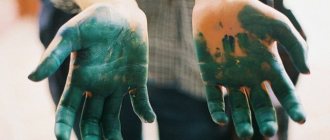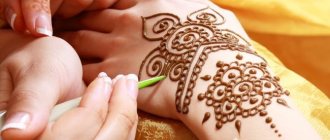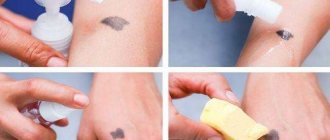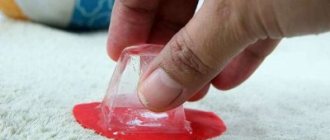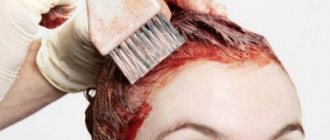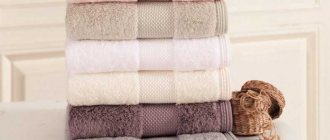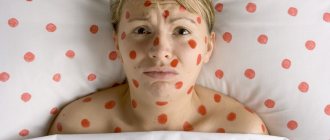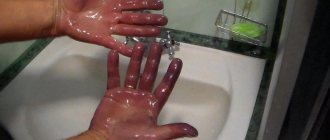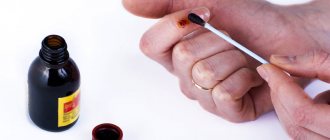We all know how little children love to draw, but what if one day your child decided that his body was a wonderful canvas and painted himself with felt-tip pens? Most often, children paint their legs, arms and their faces.
Removing marks from a felt-tip pen from the skin is not the easiest task, and if the child has also painted large areas of the skin, then you will have to work hard to bring the child to its original appearance.
Arm yourself with a list of simple and effective recommendations and get down to business, but remember that some of them should not be used unless absolutely necessary.
Alcohol solutions
It is worth using them to remove felt-tip pens if there are marks on your hands. Apply a cotton pad soaked in a 90% solution of medical alcohol to the child’s skin and hold for a couple of minutes. A child may not allow their face to be cleaned in this way due to the strong specific smell of alcohol, and there is a risk that the liquid may get into the eyes and cause severe discomfort to the baby.
The safest but very effective approaches
Regardless of what type of impact is chosen, you need to act very carefully and consistently. One method does not help; we wait until the child’s skin dries and try to do something else. It is strictly forbidden to combine ingredients from different formulations, even if individually they seem absolutely safe. First, you should try to remove the felt-tip pen using the simplest means with minimal risk of irritation. These include the following:
- Soap and very warm water. You can use either a solid bar or a liquid analogue of the product, the main thing is that it is hypoallergenic and suitable for the baby. In the first case, we rub the stains with the bar itself, in the second, with a thick washcloth. If you can’t wash everything off the first time, do several approaches with a break of at least half an hour.
- Hand cream. It should be very greasy and not moisturizing in any way. They remove markers and sunscreen compounds well. Apply the product to the contaminated area, wait 5-10 minutes, and wipe off the product with a slightly damp sponge. If necessary, repeat the manipulation.
We recommend: How should clothes be stained so that the stain has to be removed with Domestos?
Tip: Whatever product you plan to use, start the procedure by thoroughly washing the area with soap and water. This will remove the protective fat layer from the skin and increase the effectiveness of the chosen approach. After the desired result is achieved, be sure to treat the cleansed areas of the skin with a protective or moisturizing baby cream.
- Makeup remover milk. We take a cotton pad, moisten it with milk and, with gentle movements, try to erase the felt-tip pen from the baby’s skin. This is the best option if the baby managed to write all over his face. We remove the remaining product with a clean napkin and wash the child no earlier than half an hour later (this will allow you to get rid of almost unnoticeable paint residues).
All of these methods are equally effective against marks from felt-tip pens, ballpoint pens and markers.
Toothpaste
The paste has an exfoliating effect and can help remove fresh marker marks. Just try not to use a product with a strong mint scent, as the skin may tingle and the child will not want to sit if he experiences discomfort.
Apply a thin layer of paste to the skin and rub thoroughly into the marks made by felt-tip pens. To get a more effective result, you can try rubbing the skin with liquid teeth rinse on top.
Oil based felt pen
Before you wipe the oil marker off your baby's skin, you need to know the procedure. It is better not to give such stationery to a child to avoid poisoning. Their composition may be unsafe for the health of the younger generation. If your child manages to grab an object and draw with it, leaving marks on himself, you can use the following substances for cleaning:
- any oils (olive, vegetable, butter) or cream;
- hypoallergenic dishwashing detergents.
The oil will absorb dirt, and the dishwashing detergent will remove the residue from the skin.
For reference! Dishwashing liquid helps remove traces of grease from clothes.
Makeup remover milk
If you have a waterproof makeup remover in your arsenal, now is the time to put it to use. Apply a small amount to the disc and gently wipe over your baby's skin. The milk will not harm delicate baby skin or dry it out. Repeat the procedure until all traces disappear completely. Rinse off any remaining residue with water.
Methods for washing off water-based or chalk-based felt-tip pen marks
Water-based stationery is made specifically for little creators. Stains should be easily wiped off not only from your hands, but also from your clothes. To do this, you will need soap and warm water to wash away the dirt.
Chalk-based markers replace the crayons used for drawing on an easel or board. Dry chalk dries and stains the skin, but stationery can get dirty if you just touch its stem. Marks and stains can also be easily removed with warm water and soap. In some cases, it is enough to wipe the handles with a damp cloth.
Good to know! Before using a chalk-based felt-tip pen, the stationery must be shaken and then pressed on its shaft.
Adviсe:
- The best way to remove traces of any markers from the skin is time. If you don’t have any incredibly important events where your child needs to look great, then don’t rush to scrub your baby’s skin with everything you can get your hands on.
- Consider the nuances of your child’s skin. If your baby is prone to allergies and periodically experiences irritation and redness on the skin, then do not aggravate the situation by using strong products such as alcohol and nail polish remover.
- The simplest and easiest way to cleanse your skin is to take a long bath with warm water and soap. After several such procedures, any marker will disappear without a trace.
- Thoroughly moisturize your skin with cream after using any of the above methods. After active exposure, the skin may be irritated and dry, so soothe it with creams or Vaseline.
Other ways to wipe a felt-tip pen off a child’s skin
There are several other simple ways to wash a felt-tip pen from a child’s face and body. If adults do not know the composition of the marker, or rather, its basis, then you can resort to the help of improvised means:
- Toothpaste. The product must be squeezed onto the stain and rubbed until it disappears. Moderation is important here; you should not press or rub too hard, so as not to harm the delicate baby skin. After treatment, the skin area should be washed with a mouth rinse that definitely contains alcohol. After all manipulations, you need to wash your skin with soap and apply moisturizer.
- Salt scrub. It is necessary to prepare a special paste, the basis of which will be sea salt. It is mixed with a small amount of water to form a paste that must be rubbed into the stain. Cleansing occurs due to scrubbing the top layer of skin, which removes marker marks. After the procedure, the treated area must be washed with water and soap.
- Baking soda. You need to prepare a paste from it by adding a little water (for 1 tsp of powder it takes about 0.5 tsp of water). The resulting product works in a similar way to salt. The paste needs to be rubbed into the skin until all the stain is gone, and then rinsed off with warm water.
- Banana peel. It is believed that it can lighten stains. In the case of a felt-tip pen, it discolors it. You only need to take the peel of a ripe banana and rub the inside of it on the surface of the skin. After treatment, the problem area should be washed with water and dried. If necessary, the manipulation can be repeated.
To prevent a child from drawing on himself, you need to explain to him that such stains are very difficult and painful to wash off. In addition, it is useful to keep the baby occupied, to show him how interesting it is to color his mother’s drawings and draw in the album. But dirt can appear accidentally, so mom should always be fully prepared and know exactly how to wipe the felt-tip pen off the skin.
Main types of markers
Felt pens can have several types of bases:
- water;
- alcohol;
- fat;
- chalk;
- paintwork.
It depends on the base of the marker with which your child drew himself and you need to choose a method for removing stains. For example, marks from alcohol-based markers can be removed with medical alcohol and other alcohol-containing products.
Marker marks containing fat can be easily removed with sunflower, coconut, olive oil or rich cream. If you have Vaseline on hand, use it.
What is the difference between a marker and a felt-tip pen?
Now the market is saturated with various goods. Most buyers think that thick markers are markers. Despite the fact that they are made identically, in fact the products differ from each other in composition.
Markers contain alcohol. They are resistant to water. The inscriptions made by them will have to be difficult to remove from any surfaces. Draw with a colorful pencil on plastic, wood, metal, fabric. If a stain occurs on clothing, it is unlikely to be able to be wiped off with improvised means. Chemicals will be needed to remove the contamination. Markers are often used in production to indicate the required parameters and dimensions.
Felt-tip pens, like markers, contain a coloring substance that flows to the tip. The stationery contains water, not alcohol or oil. Draw with it on paper. When exposed to moisture, the design begins to blur and spread.
Creams
Sunscreen has the best effect in this regard. Its composition is quite oily, but does not damage the baby’s skin. Although, in the absence of one, you can choose any other oil-based cosmetic product - for the face, hands, etc.
To remove marker marks, simply squeeze a little cream onto a dirty surface and rub in in a circular motion for several minutes. All that remains is to rinse off the resulting foam under the tap and a little paint will come off your hand. If necessary, the procedure is repeated several times.
Baby oil
In the case of any fat composition, you can use a similar substance to cleanse it. And in order to cause less harm to the baby’s delicate skin, it is better to take a special massage product.
It is applied in a small amount to the painted area and rubbed into the surface using a wet cotton swab or rag. At the same time, try to make your movements as carefully and gently as possible. If the stain was applied a long time ago and the mark has become ingrained, you may need to repeat the procedure.
What to do with very stubborn stains?
If the listed compositions do not help, and you need to wash off the felt-tip pen urgently, you can try one of the following approaches:
- Antiseptic. Apply the composition directly to the traces of paint and wipe them off with a soft cloth or napkin for half a minute. After this, rinse the skin with water and dry.
- Salt. This option is not suitable for treating very delicate skin, for example on the face. First, soak the area for 10 minutes (you can even take a bath), after which we apply very fine salt to the still damp skin and gently rub in for a few seconds. Can be repeated up to three times.
- Alcohol. We moisten a cotton swab with alcohol and apply it to the drawing. After a few seconds it should lighten or even disappear. No need to rub anything!
It is worth considering that when working with delicate children's skin, it is prohibited to use such effective products as boric acid and nail polish remover. It’s better to spend a little more time, but wash the product without risks.
We recommend: What contaminants and how can you remove them with cola?
How to clean a marker board?
Sometimes, when using a marker board for a long time, the paint from the previous inscriptions is not completely washed off, the canvas loses its white color, and it becomes a problem to see the text on it. If you regularly follow a few tips, you can not only remove permanent marker from your board, but also keep it clean.
- The simplest remedy is an eraser. From a flat surface, it can easily erase inscriptions with a marker or felt-tip pen.
- Fat cream can also save you from streaks on the board. Apply it for fifteen minutes and then wipe with a dry, clean cloth.
- Do not rush to throw away the coffee filter after use. It will also be useful when you need to clear the board. Apply it to dirt and then wipe dry with a napkin.
- A soft melamine sponge will also come in handy when dealing with a dirty board. It is sold in hardware stores. The sponge has a slight abrasive effect. Works like an eraser, but removes dirt much more effectively.
Attention! When cleaning a smooth marker board, do not use powder products; they will scratch the surface.
Warm water
The easiest way to remove chalky and water-based compounds is that they can be easily cleaned under the tap. But the same method can be used if other markers were also used for drawing, but the trace from them did not have time to become embedded in the surface of the skin.
If your child just left a stain, take him to the bathroom and try to quickly wash off the paint. To do this, take a bar of soap and rub the stain. Next, wash the solution off your body. If you only have liquid soap on hand, you will need to take an additional washcloth to remove dirt.
When the area outlined with a felt-tip pen is too large, it is better to wash the child in the shower or in the bathtub. Even if the marks did not immediately disappear, after this procedure they became less noticeable. After a few days, the stains will be completely removed from the surface.
How to care for white sofas
White sofas are perhaps the most difficult interior items to care for. They show settled dust, abrasions, grease and stains of any origin.
Maintaining the cleanliness and beauty of such a sofa is troublesome. The easiest way to maintain a presentable appearance of a white leather sofa is to:
- Remove dust regularly with a vacuum cleaner.
- Carry out wet cleaning with a flannel or microfiber cloth soaked in a soapy solution. After cleaning, the surface should dry naturally. It is advisable to carry out this procedure at least once a week (it can also be carried out after each dry cleaning).
- Polish the surface. Both special products and simple castor oil are suitable for the procedure, a small amount of which must be completely rubbed into the upholstery using a flannel (until it dries completely). The frequency of polishing is once every -5 months.
- If necessary, remove grease; ammonia diluted in water is excellent for this.
Regular cleaning of white sofas is the key to their good appearance.
Eco leather care:
- Regular dry vacuuming.
- Wet cleaning with a weak soap solution using flannel or special wet wipes, followed by wiping dry with a soft cloth.
- Restoring the surface with a stearin sponge (the procedure prevents cracking).
- If necessary, remove scratches using “liquid skin”.
You can neutralize scratches from such a sofa using “liquid leather”.
Caring for a white fabric sofa (suitable for natural and synthetic textiles):
- Regular vacuuming.
- Regular and thorough wet cleaning with chemical aerosols (aerosols do not moisten the fabric so much and it dries quickly enough) using a damp sponge or a special brush if the fabric is velor.
A white fabric sofa can be maintained using a vacuum cleaner and chemical sprays.
The use of hair dryers and other heating devices to speed up the drying of all types of upholstery is not recommended!
It is quite possible to save an expensive leather covering from felt-tip pen marks; the main thing is to correctly determine the base of the dye and choose the appropriate means to combat it. Solvents will help deal with the most persistent and deep paint stains, alcohol-based products will neutralize the alcohol base, and oil dyes can be removed using fat-soluble detergents.
Shaving cream
These compositions are distinguished by the presence of soap solution and oil. Therefore, they are able to remove marks from felt-tip pens from different manufacturers. You need to squeeze a little product out of the bottle and apply it to the skin. Leave the cream like this for a few minutes so that it has time to be absorbed. Then you will have to use a soft cloth soaked in water to wipe the area in a circular motion and wash off the dirt under the tap.
Baking soda
A similar composition can be made from soda. This substance has similar properties, but at the same time, due to its smaller grains, it is less abrasive and traumatic to the skin.
You can prepare this scrub in the same way as the previous one. To do this, dilute baking soda with water to a paste consistency and treat the contaminated surface. At the end, be sure to rinse your baby’s skin well with water.
Banana
The inner part of the peel of this fruit has whitening and cleansing properties. Therefore, to eliminate marks from a felt-tip pen or marker on a child’s hand, you can use this method. The important thing is that the banana peel will carefully remove all contaminated traces without damaging the delicate skin.
Take a ripe banana, peel it and wipe the inside of the problem area. The procedure lasts several minutes in a row, and at the end it is enough to rinse the area with water. If the stain is too deep, you can repeat the steps again, but to do this, take another piece of peel that has no paint residue on it.
How is the world known?
So, how to remove a felt-tip pen from a child’s skin? For most parents with small children, this question has become one of the most pressing for several years. It cannot be otherwise. Kids learn to explore the world, they are interested in literally everything. Any object can attract their attention. What can we say about bright markers?
When a bag of these “magic” wands falls into little hands, children immediately get the idea of drawing on any surface they see in front of them. It is no less interesting for them to paint their bodies. Indeed, it’s so fun when beautiful flowers bloom on your pink belly, and the sun shines brightly on your arms and legs, or rain drips from blue clouds!
How is the world known?
How to wash a felt-tip pen from a child’s skin, especially if we are talking about his own face? After all, the skin of a little tomboy is so delicate and sensitive to any irritant.
You can try a number of aids that will be discussed in this article. Just rubbing it too hard is not recommended, so as not to cause an allergy.
Salt
To make a natural scrub to remove marker marks, you need to take a tablespoon of sea salt and add just enough water to it to make a paste consistency.
This mixture has cleansing and abrasive properties, which leads to the effect of removing even stubborn marks from the surface. But in order not to damage the delicate skin, rub the product very carefully. At the end, do not forget to thoroughly rinse the treated area with warm water.
Video material
We hope that the methods given in the article for removing ink from delicate surfaces of the body will help you cleanse your child of the results of creativity and at the same time not spoil the mood of the little genius. And even better, if there is such an opportunity - do nothing, leave everything as it is - the dyes will come off on their own in a couple of days. Just wash your child’s hands more often and give him a full bath once a day more, because in this case you won’t need to use any dubious means.
No similar posts
Nail polish remover
You can wash the marker off your skin using the liquid you use to remove nail polish marks. Among the ingredients of this type of product you can find a certain amount of isopropyl alcohol, as well as acetone, which together can dissolve dirt and, without any extra effort on your part, remove traces of marker that cannot be washed off with water.
- Soak a small piece of cotton wool with nail polish remover and then rub onto the slightly stained area.
- There is a chance that you will need to leave the soaked cotton wool for some time for the product to take effect.
